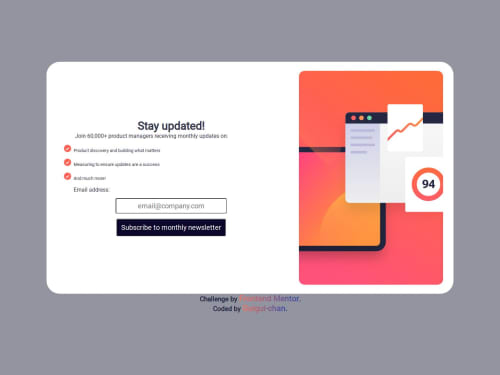Stay updated using JavaScript!

Solution retrospective
For I re-created the basic concept of a form sumition had in my mind, I felt like I was doing something usefull, equal to what I had found to be "magic" before and, of course, updated!
What challenges did you encounter, and how did you overcome them?The two sections have diferent shapes. On desktop, only. That was surprising and pattern breaking! Confortzone-kun doesn't like that sort of stuff °^°!
As usuall, I used ids to overcome it, by iding each section and setting the non-maching styles trough them. Sure it is easyer to understand than setting the style in DOM itself, but I would still like to learn a thirth way to do it that is better than both, since I literally set two ids to control a single slight diference.
What specific areas of your project would you like help with?I am extreamely new to forms and, as has our friend said in the suggested by the learningpath article, they are hard! Any little tip is winning.
Please log in to post a comment
Log in with GitHubCommunity feedback
- @mike15395
congratulations @Guilherme-Porto-Silva on completing this challenge! You need to improve a lot by making following changes: 1.Use email regex for checking valid email, you can check following function,
function validateEmail(email) { const pattern = /^[^\s@]+@[^\s@]+\.[^\s@]+$/; return pattern.test(email); }the above function return a boolean value, based on which you can naviagte to success message or not.
This is the major change in your code and rest are UI changes just look at design more carefully.
Happy Coding!
Join our Discord community
Join thousands of Frontend Mentor community members taking the challenges, sharing resources, helping each other, and chatting about all things front-end!
Join our Discord